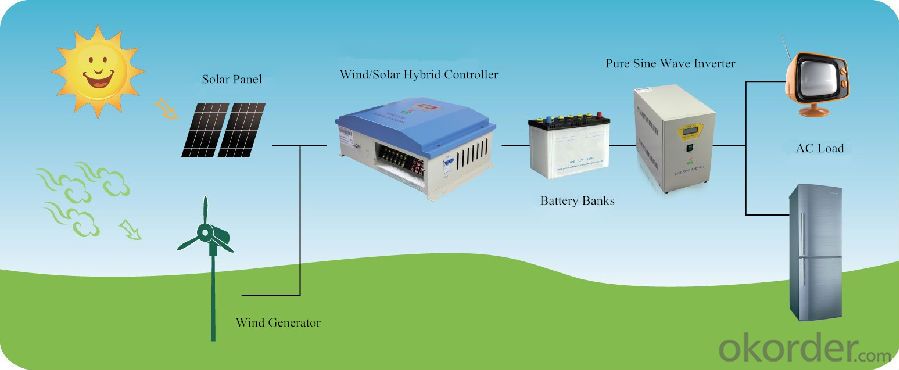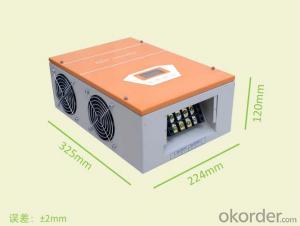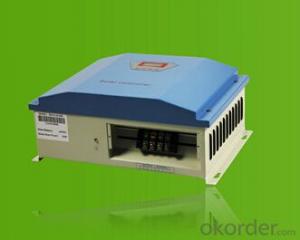1KW-MPPT Charging Function-Solar Charge Controller
- Loading Port:
- Shanghai
- Payment Terms:
- TT or LC
- Min Order Qty:
- 1 unit
- Supply Capability:
- 10000 unit/month
OKorder Service Pledge
OKorder Financial Service
You Might Also Like
I. PRODUCT INTRODUCTION
Solar controller is control device which can control solar panel and transform solar energy into electricity then store to the battery bank. Solar controller is the most important part in off-grid system, whose performance has much effect on life expectancy and operation of the whole system, especially the battery expectancy. Or battery service life will be shortened by over charge or over discharge.
II. PERFORMANCE FEATURES
Superior military-grade components to ensure the product stability.
Perfect protection function, thus the system has higher reliability.
Check and set all operation parameters as requirement from LCD display.
PWM stepless unload mode, which burn the excess power into Dump load, making the battery charging in best status.
III. APPLICATION AREAS
Standalone Photovoltaic power station
Standalone Domestic household photovoltaic power system
Mobil communication base stations, expressway and other non-residential regions.
Coastal islands, remote mountainous, border posts for regions shortage of or without electricity.
Government demonstration projects, landscape lighting project etc.
IV. 1KW TECHNICAL PARAMETERS
Product Model | WS10-24-N00 | WWS10-48-N00 |
Rated battery power | 24V | 48V |
Rated solar input power | 1 kW | 1 kW |
Floating charge voltage | 29V | 58V |
Max Open Circuit Voltage | 50V | 100V |
Dimensions (L x W x H) | ||
Net Weight | 7kg | |
Display mode | LCD | |
Cooling | Fan | |
Protection Level | IP20(Indoor) | |
Quiescent current | ≤20 mA | |
Battery over charge; battery anti-reverse-connection; solar reverse charge protection; solar anti-reverse-connection; lightning protection. | ||
Ambient temperature | -20~+55℃ | |
Ambient humidity | 0~93%, without condensing | |
Working altitude | ≤4000m | |
In order to serve our customers better, our company can adjust parameter configuration according to customer’s requirement. | ||

- Q:Can a solar controller be used with solar-powered water treatment plants?
- Yes, a solar controller can be used with solar-powered water treatment plants. A solar controller is responsible for regulating and optimizing the charging and discharging of batteries in a solar system. Since solar-powered water treatment plants rely on solar panels to generate electricity, a solar controller is essential to ensure efficient utilization of solar energy and to protect the batteries from overcharging or excessive discharge.
- Q:How does a solar controller handle variations in solar panel degradation?
- A solar controller handles variations in solar panel degradation by continuously monitoring the output of the solar panels and adjusting the charging parameters accordingly. It uses advanced algorithms to detect any decrease in performance due to degradation and compensates by optimizing the charging current and voltage to ensure optimal energy production and battery charging. This helps to maximize the lifespan of the solar panels and maintain their efficiency over time.
- Q:What are the key features to look for in a solar controller?
- The key features to look for in a solar controller include maximum charging current and voltage, compatibility with different battery types, temperature compensation, load control capabilities, and advanced protection measures such as overcharge, over-discharge, and reverse polarity protection.
- Q:What is the maximum load current of a solar controller?
- The maximum load current of a solar controller depends on the specific model and its specifications. It can vary widely, ranging from a few amps to several hundred amps, depending on the size and capacity of the solar controller.
- Q:How often should a solar controller be replaced?
- A solar controller typically does not need to be replaced very often, as it is a durable component designed to last for many years. However, it is recommended to replace the solar controller every 10-15 years to ensure optimal performance and efficiency of the solar system.
- Q:Can a solar controller be used with different types of solar panel grounding systems?
- Yes, a solar controller can be used with different types of solar panel grounding systems. The solar controller is responsible for regulating the charge coming from the solar panels and managing the flow of electricity to the batteries or grid. It does not depend on the grounding system of the solar panels, which is mainly for safety purposes. However, it is important to ensure that the solar controller is compatible with the type of solar panel grounding system being used to ensure proper functionality and safety.
- Q:How do I calculate the maximum load output current for a solar controller in a grid-tied system?
- To calculate the maximum load output current for a solar controller in a grid-tied system, you need to consider the specifications provided by the manufacturer. Look for the maximum load capacity or output current rating mentioned in the product datasheet or manual. This value represents the highest current that can be safely drawn from the solar controller's load output. It is crucial to adhere to this limit to prevent any damage to the controller or the connected devices.
- Q:How does a solar controller prevent overvoltage in the system?
- A solar controller prevents overvoltage in the system by continuously monitoring the voltage levels of the solar panel and battery. When the voltage exceeds a certain threshold, the controller automatically regulates the charging process to prevent excessive charging and potential damage to the batteries. It accomplishes this by reducing the charge current or diverting the excess energy to a secondary load, thereby maintaining a safe and optimal voltage level in the system.
- Q:How does a solar controller handle load control for powering other devices?
- A solar controller handles load control for powering other devices by regulating the power flow from the solar panels to the devices. It monitors the battery voltage and adjusts the charging and discharging process accordingly to ensure that the connected devices receive the appropriate amount of power. This prevents overcharging or discharging of the battery and protects the devices from potential damage.
- Q:How do you prevent battery sulfation with a solar controller?
- Battery sulfation can be prevented with a solar controller by employing a smart charging algorithm that includes a desulfation mode. This mode periodically sends high voltage pulses to the battery, effectively breaking down any lead sulfate crystals that may have formed on the battery plates. By regularly applying this desulfation process, the solar controller helps to prevent and reverse sulfation, ensuring optimal battery performance and longevity.
1. Manufacturer Overview |
|
|---|---|
| Location | |
| Year Established | |
| Annual Output Value | |
| Main Markets | |
| Company Certifications | |
2. Manufacturer Certificates |
|
|---|---|
| a) Certification Name | |
| Range | |
| Reference | |
| Validity Period | |
3. Manufacturer Capability |
|
|---|---|
| a)Trade Capacity | |
| Nearest Port | |
| Export Percentage | |
| No.of Employees in Trade Department | |
| Language Spoken: | |
| b)Factory Information | |
| Factory Size: | |
| No. of Production Lines | |
| Contract Manufacturing | |
| Product Price Range | |
Send your message to us
1KW-MPPT Charging Function-Solar Charge Controller
- Loading Port:
- Shanghai
- Payment Terms:
- TT or LC
- Min Order Qty:
- 1 unit
- Supply Capability:
- 10000 unit/month
OKorder Service Pledge
OKorder Financial Service
Similar products
New products
Hot products
Hot Searches
Related keywords





























